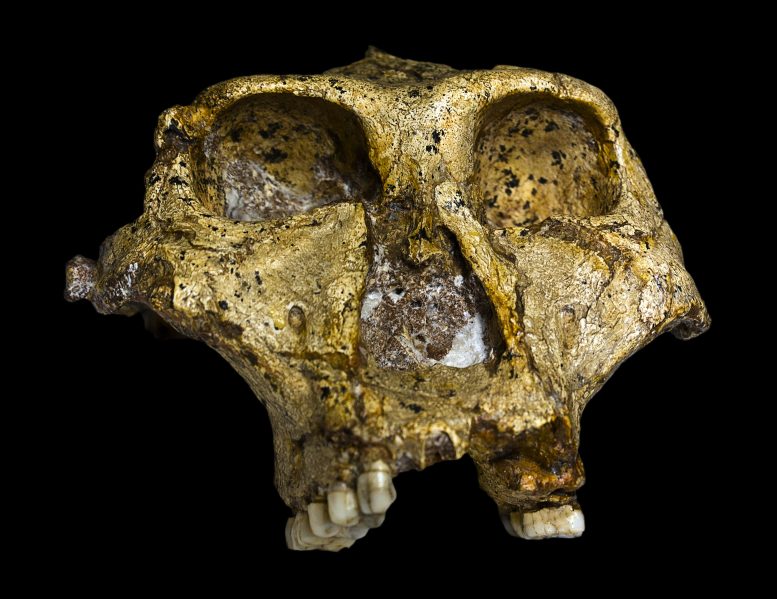
The original complete skull (without mandible) of a 1,8 million years old Paranthropus robustus (SK-48 Swartkrans (26°00’S 27°45’E), Gauteng,), discovered in South Africa. Collection of the Transvaal Museum, Northern Flagship Institute, Pretoria South Africa. Credit: Ditsong National Museum of Natural History, CC BY-SA 4.0
New research led by the University of Kent has found evidence that human ancestors as recent as two million years ago may have regularly climbed trees.
Walking on two legs has long been a defining feature to distinguish modern humans, as well as extinct species on our lineage (aka hominins), from our closest living ape relatives: chimpanzees, gorillas, and orangutans. This new research, based on an analysis of fossil leg bones, provides evidence that a hominin species (believed to be either Paranthropus robustus or early Homo) regularly adopted highly flexed hip joints; a posture that is associated with climbing trees in other non-human apes.
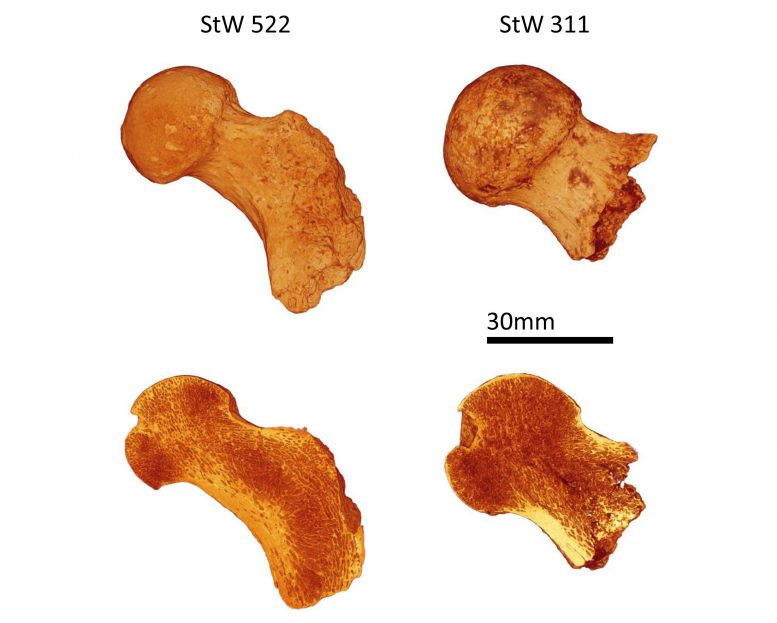
CT-based digital renderings of the StW 522 (Australopithecus africanus) and StW 311 (Paranthropus/Homo) fossils. The top two images show the fossils as they are preserved. The bottom two images show a cross-sections through the fossils to reveal the trabecular bone, whose distribution reveals these individuals practiced different frequencies of climbing. Credit: Matthew Skinner
These findings came from analyzing and comparing the internal bone structures of two fossil leg bones from South Africa, discovered over 60 years ago and believed to have lived between 1 and 3 million years ago. For both fossils, the external shape of the bones were very similar showing a more human-like than ape-like hip joint, suggesting they were both walking on two legs. The researchers examined the internal bone structure because it remodels during life based on how individuals use their limbs. Unexpectedly, when the team analyzed the inside of the spherical head of the femur, it showed that they were loading their hip joints in different ways.
The research project was led by Dr. Leoni Georgiou, Dr. Matthew Skinner, and Professor Tracy Kivell at Kent’s School of Anthropology and Conservation, and included a large international team of biomechanical engineers and paleontologists. These results demonstrate that novel information about human evolution can be hidden within fossil bones that can alter our understanding of when, where, and how we became the humans we are today.
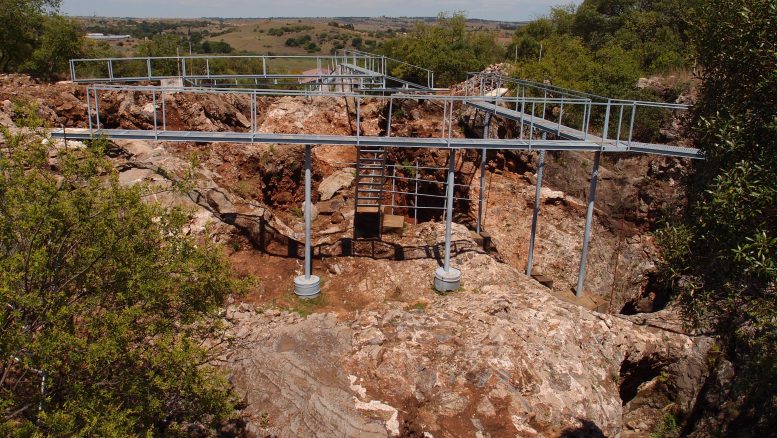
Photograph of the fossil-and artifact-bearing surface exposed deposits of the Sterkfontein Cave site. View looking towards the west. Credit: Dominic Stratford
Dr. Georgiou said: ‘It is very exciting to be able to reconstruct the actual behavior of these individuals who lived millions of years ago and every time we CT scan a new fossil it is a chance to learn something new about our evolutionary history.’
Dr. Skinner said: ‘It has been challenging to resolve debates regarding the degree to which climbing remained an important behavior in our past. Evidence has been sparse, controversial, and not widely accepted, and as we have shown in this study the external shape of bones can be misleading. Further analysis of the internal structure of other bones of the skeleton may reveal exciting findings about the evolution of other key human behaviors such as stone tool making and tool use. Our research team is now expanding our work to look at hands, feet, knees, shoulders, and the spine.’
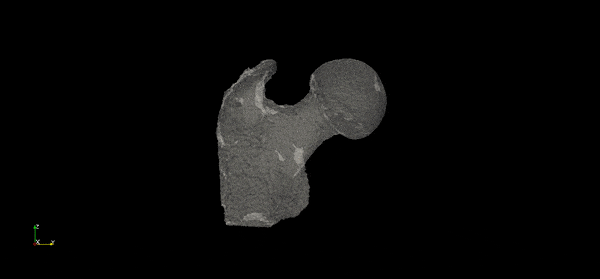
Animation showing the double pillar of spongy bone in the head of the femur of a gorilla. One pillar is linked to walking on all four limbs on the ground and one pillar is linked to a highly flexed leg during climbing. Credit: Christopher Dunmore
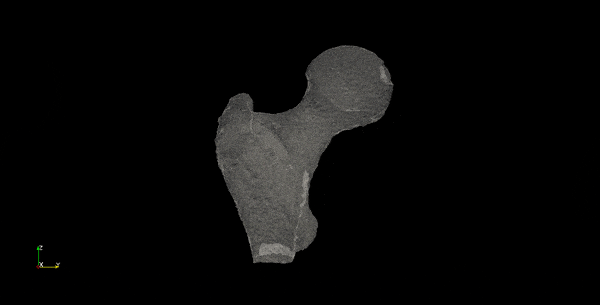
Animation showing the single pillar of spongy bone in the head of the femur of a human. This pillar is linked to walking on two legs on the ground. Credit: Christopher Dunmore
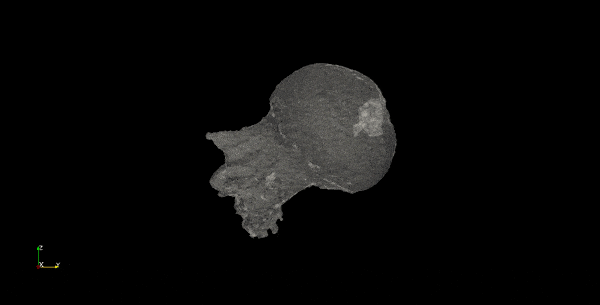
Animation showing the double pillar of spongy bone in the head of the femur of the fossil StW 311. We suggest that one pillar is linked to walking on two legs on the ground and one pillar is linked to a highly flexed leg during climbing. Credit: Christopher Dunmore
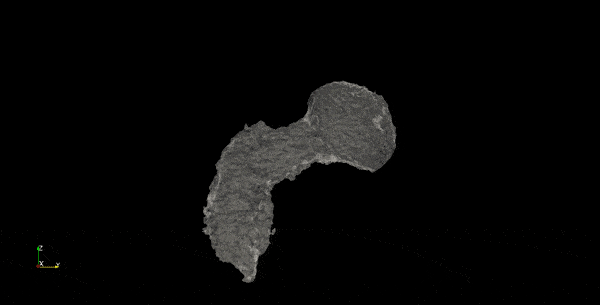
Animation showing the single pillar of spongy bone in the head of the femur of the fossil StW 522. This pillar is linked to walking on two legs on the ground. Credit: Christopher Dunmore
What aspect of human evolutionary history is this study about?
This study is about a central issue in human evolutionary studies: the origins of bipedalism (walking on two legs) in the human lineage. While we know that all human ancestors practiced some form of bipedalism, when (and which) human ancestors walked in the same way as modern humans remains unclear. This study addresses this question by examining, in a novel way, the internal structure of fossil leg bones from South Africa.
What is a hominin?
A “hominin” is a human ancestor. It refers to any fossil species that is more closely related to humans than to chimpanzees or bonobos. The earliest hominins are typically identified as such by skeletal features that show they walked on two feet (were a bipedal) and by features of their teeth, such as small canines.
Background to the study
We have an increasingly rich sample of fossils from our human ancestors, particularly from South and Eastern Africa. We identify these fossils as being related to humans by features in the skeleton that show they walked on two legs; i.e. they were bipedal. Thus, all fossil human ancestors or hominins were bipeds. However, there is increasing evidence that different fossil hominin species may have walked bipedally in ways that are different from that of modern humans.
Furthermore, many fossils still show ape-like (e.g. chimpanzee or orangutan) features in their skeletons, especially within the upper limbs. Thus, there has been a longstanding debate about the significance of climbing (arboreal locomotion) in our evolutionary history and whether our ancestors were fully committed to only walking on the ground, or if life in the trees was still an important part of their adaptive lifestyle.
It has been challenging to find any resolution to debates about how exactly our ancestors walked bipedally and if they still climbed in trees because the external shape of bones can be misleading. In particular, it is not clear if the ape-like features in some fossils were still functionally useful, or if they were simply retentions from a more arboreal ancestor that had not yet been lost (i.e. behavior can evolve faster than morphology).
To address this challenge, we looked at two fossil hominin hip joints from Sterkfontein, South Africa that, from the external shape, show clear adaptations for bipedalism. The internal structure of bone is shaped by behaviors carried out over growth and development to a greater extent than the external morphology. We therefore analyzed the internal bone structure of these fossils in comparison to humans and other living apes to see if we could learn more about how each of the fossil human ancestors moved in their respective environments.
What part of the human fossil record did we study?
The internal bony structure of the hip joint of human ancestors from Sterkfontein Cave, Cradle of Humankind, Gauteng Province, South Africa. In particular, we studied two fossils discovered over 60 years ago that lived between 1 and 3 million years ago. The fossils are:
- StW 522, a proximal femur (hip joint of the thigh bone) attributed to Australopithecus africanus and dated to 2.0-2.8million years ago (Ma)
- StW 311, a proximal femur dated to 1.1-2.18 Ma and may be attributed to either Paranthropus robustus or a species of early Homo (e.g., Homo habilis).
Although StW 311 is absolutely larger in size, both specimens show very similar external morphology and both have been previously interpreted as practicing the same form of locomotion. See also the Supporting Material associated with the study.
What did our research team do?
Our analysis is based on high-resolution microtomography (microCT) data, which is similar to medical CT data but at a much finer resolution. These data allow us to see inside the fossils to reveal the internal bone structure. Bones are made up of a hard outside shell called the cortex or cortical bone, and a spongy network of bone under the joints, called trabecular or cancellous bone. Bone remodels during an individual’s life in response to how it is loaded; where load or stress is high, bone will be added and where stress is lower, bone will be removed. This means that the internal bone structure may tell us more about how an individual moved around during its lifetime than the external shape of the bone. We analyzed the internal bone structure in the two South African fossils and compared it to that of modern humans, as well as our closest living relatives: chimpanzees and gorillas, which engage in both knuckle-walking and climbing, and orangutans that spend most of their life in the trees using climbing, clambering and suspension.
What did we find?
For our two fossils, the external shape of the bones was very similar showing a more human-like than ape-like hip joint that clearly suggests they were both walking on two legs. However, when we analyzed the internal trabecular structure, it showed that they were loading their hip joints in different ways. The older, StW 522, A. africanus fossil showed a trabecular structure with one “pillar” of denser bone struts, similar to that seen in humans, suggesting it predominantly loaded its hip joint when moving bipedally on the ground. The younger StW 311 fossil, however, showed an ape-like trabecular structure with two “pillars” suggesting that some of the time it loaded its hip joint when moving bipedally on the ground, but for a substantial amount of time it also adopted a highly flexed hip posture that is needed, for example, when climbing.
Although we are not sure if StW 311 is P. robustus or early Homo, it shows that there was greater variability in hominin locomotion between 1-2 million years ago than we previously thought, and that climbing was still an important part of these species adaptive repertoire.
Why is evidence for regular climbing behavior in this human ancestor important?
Bipedalism, or walking on two legs, is the key defining feature that differentiates humans from our closest living ape relatives: chimpanzees, bonobos, gorillas, and orangutans. It is also a trait that is shared by all human ancestors from the earliest to the humans today. The earliest human ancestors (living between 4-7 million years ago) show evidence for occasional bipedality but also regular climbing in an arboreal environment.
However, by ~2 million years ago the general consensus has been that both Paranthropus and early Homo were spending almost all of their time walking bipedally on the ground. There has been some speculation that these species might have practiced periodic bouts of climbing but the evidence has been sparse, controversial and not widely accepted. Our results provide direct evidence that the members of one of these species regularly adopted highly flexed hip joints; a posture that in other non-human apes is associated with climbing trees.
What are the other implications for the results of this study?
First, we expect that this approach will be used to better understand how other older and younger fossil hominin species moved around and to what degree climbing might have remained an important part of their locomotor repertoire. Second, almost all bones of the skeleton contain the spongy bone we studied and thus it is possible to examine how other behaviors (e.g., stone tool making, tool use, running, etc.) might have left a signal in the fossilized remains of our ancestors. Our research team is expanding our work to hands, feet, knees, shoulders, and the spine.
What do we know about the South African hominin species Australopithecus africanus, Paranthropus robustus and early Homo?
Australopithecus africanus lived from about 2-3 million years ago. There are multiple fossils from this species, including the famous skulls called “Mrs. Ples” and the Taung child, as well as a partial skeleton that shows it was a biped, but with relatively longer arms than humans have today. It is considered a ‘gracile’ australopith as its skull is less powerfully built than the ‘robust’ australopiths such as Paranthropus robustus.
In contrast, Paranthropus robustus is one of the three species of ‘robust’ fossil australopiths characterized by its extremely large teeth (molars and premolars), broad cheekbones, and evidence of large chewing muscles. Paranthropus robustus is known from several fossil sites in South Africa and lived from about 2 to 1 million years ago. It is largely known from skulls and teeth, but there are some new fossil skeleton discoveries that suggest it may have also used its arms for climbing in trees, as well as being a habitual biped.
There are several fossils from South African sites that are considered to belong to early members of our own genus Homo, such as Homo habilis or Homo erectus. These fossils are identified as early Homo based primarily on having smaller, more human-like teeth compared to both P. robustus and A. africanus. H. habilis lived from 2.4 to 1.4 million years ago and is found throughout South Africa and East Africa. H. habilis is generally thought to be the maker of Oldowan stone tool technology, which comprises some of the earliest stone artifacts. It was also a biped but due to a limited fossil record, there is a much debate about whether or not it still climbed in trees.
H. erectus lived from 1.9 million years ago to as recently as 100,000 years ago. It is found throughout South and East Africa, and is typically considered the first fossil human species to leave Africa, with fossils throughout Europe and Asia. The H. erectus skeleton looks very similar to that of modern humans, with longer legs and shorter arms and it is generally thought to have walked and run in a manner similar to us. It is associated with the more complex Acheulean technology.
What period of human evolution are these fossils from?
These fossils are from a geological epoch called the Pleistocene. This period is from 2.6 million years ago to 12,000 years ago (the start of the Holocene). These fossils are from the early part of this epoch, the Early Pleistocene, which lasted from 2.6 million to 800,000 years ago, when there were multiple species (and genera) of fossil hominins living at the same time.
Why do palaeoanthropologists avoid using the term ‘missing link’?
The fossil evidence for human evolution reveals that our branch of the ‘tree of life’ did not consist of a single lineage with species evolving consecutively from one to the next. Rather, our branch is ‘bushy,’ consisting of multiple lineages and with some of these lineages existing at the same time. For example, the Paranthropus lineage and the Homo lineage overlap in time and space. Thus, it is inappropriate to characterize any particular fossil as ‘the missing link.’
Reference: “Evidence for habitual climbing in a Pleistocene hominin in South Africa” by Leoni Georgiou, Christopher J. Dunmore, Ameline Bardo, Laura T. Buck, Jean-Jacques Hublin, Dieter H. Pahr, Dominic Stratford, Alexander Synek, Tracy L. Kivell and Matthew M. Skinner, 30 March 2020, Proceedings of the National Academy of Sciences.
DOI: 10.1073/pnas.1914481117



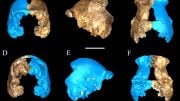
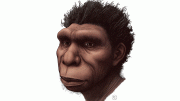

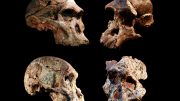
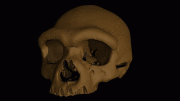

Be the first to comment on "Recent Human Ancestor Regularly Climbed Trees Like Apes"